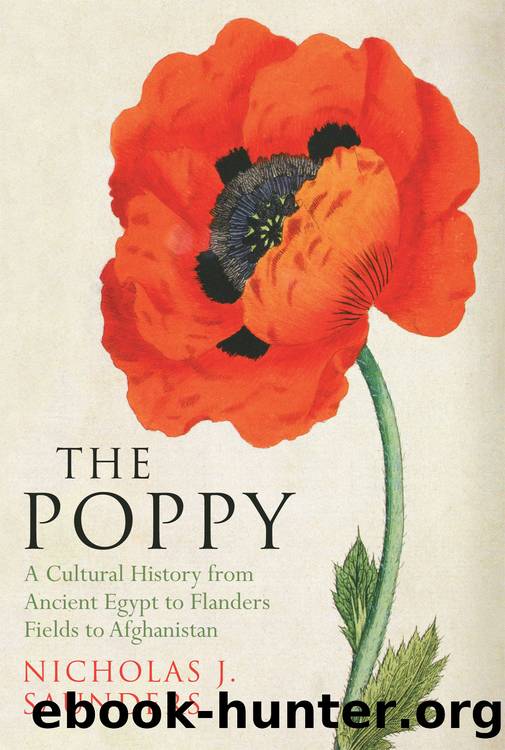The Poppy: a Cultural History from Ancient Egypt to Flanders Fields to Afghanistan by Nicholas J. Saunders

Author:Nicholas J. Saunders [Saunders, Nicholas J.]
Language: eng
Format: epub
Tags: Flanders Fields, Ancient Egypt, The Opium Wars, First World War, Remembrance Day, Royal British Legion, American Civil War, Afghanistan, Iconic flowers
Publisher: Oneworld Publications
Published: 2013-09-10T00:00:00+00:00
Anna Guérin and her French war widows sold millions of Remembrance Poppies around the world during the early 1920s. The money raised transformed the lives of families and orphans in the devastated battlefields. Yet, for all Guérinâs success, the French did not embrace the poppy as the singular symbol of the war dead. The reason was simple. In France, luxuriant garlands of colourful, sweet-scented blooms had âlong been displayed at funerals.64 These were unlikely to be displaced by the flimsy, odourless and weed-like corn poppy. And if any single flower in French culture is associated with death, tombs and remembrance, it is the chrysanthemum, the âgolden flowerâ, which blossoms in the autumn, the time when death, in nature, is near. Each year, chrysanthemums adorn French cemeteries on âAll Saintsâ Day, 1 November65 â and very few of the war dead would not be considered to be among our most hallowed souls.
The association of the chrysanthemum with the dead is seen across Catholic Europe, from France âto Italy to southern Germany.66 These nationsâ Protestant neighbours did not share such deathly associations with the autumnal flower, not least because the tradition of laying cut flowers on graves emerged in the Netherlands in the sixteenth century, âafter the Church had divided.67 While flowers were displayed at their funerals, the English, despite the Victorian âlanguage of flowersâ, did not have a specific bloom tied to spirituality and the dead; the cypress tree held that honour. Thus, the poppy was perfectly placed to fill this void in Britain. For the Catholic French, however, the religious connotations of flowers were so deeply embedded in the national psyche that even the trauma of the First World War could not dislodge them.
While the poppy has no sentimental attachments and is devoid of any spiritual feelings for the French people, it has become a highly visible badge of remembrance for British and Commonwealth visitors to the Somme, and a commercially valuable logo for the local tourist economy. This may have influenced Pascal Truffautâs idea of a poppy-sown commemorative corridor from Calais to the battlefields, which was described in the first pages of this book.
The French possess their own distinctive flower to commemorate their war dead, the blue cornflower (Centaurea cyanus), which was adopted unofficially during the Great War as its colour matched the spotless uniforms of raw recruits newly arrived at the front. Those already in the trenches had long since seen their clothing stained by mud and filth, and so the young soldiers soon became known as les Bleuets (âthe bluesâ). During and after the war, two women working at the Hôtel des Invalides in Paris organised a workshop where disabled French soldiers could make cloth versions of the cornflower to commemorate the dead and help support themselves financially. The cornflower became the official French âflower of remembrance in 1920.68
In 2008, the towns and villages of northern France celebrated the ninetieth anniversary of the end of the First World War with a profusion of floral displays. The âCampaign
Download
This site does not store any files on its server. We only index and link to content provided by other sites. Please contact the content providers to delete copyright contents if any and email us, we'll remove relevant links or contents immediately.
| Cacti & Succulents | Flowers |
| Mushrooms | Trees |
Sapiens: A Brief History of Humankind by Yuval Noah Harari(13921)
The Tidewater Tales by John Barth(12372)
Mastermind: How to Think Like Sherlock Holmes by Maria Konnikova(6895)
Do No Harm Stories of Life, Death and Brain Surgery by Henry Marsh(6659)
The Thirst by Nesbo Jo(6407)
Why We Sleep: Unlocking the Power of Sleep and Dreams by Matthew Walker(6303)
Life 3.0: Being Human in the Age of Artificial Intelligence by Tegmark Max(5149)
Sapiens by Yuval Noah Harari(5094)
The Longevity Diet by Valter Longo(4835)
The Body: A Guide for Occupants by Bill Bryson(4539)
The Rules Do Not Apply by Ariel Levy(4485)
The Immortal Life of Henrietta Lacks by Rebecca Skloot(4224)
Why We Sleep by Matthew Walker(4171)
Animal Frequency by Melissa Alvarez(4126)
Yoga Anatomy by Kaminoff Leslie(4085)
The Hacking of the American Mind by Robert H. Lustig(4051)
All Creatures Great and Small by James Herriot(3951)
Barron's AP Biology by Goldberg M.S. Deborah T(3925)
Double Down (Diary of a Wimpy Kid Book 11) by Jeff Kinney(3876)
